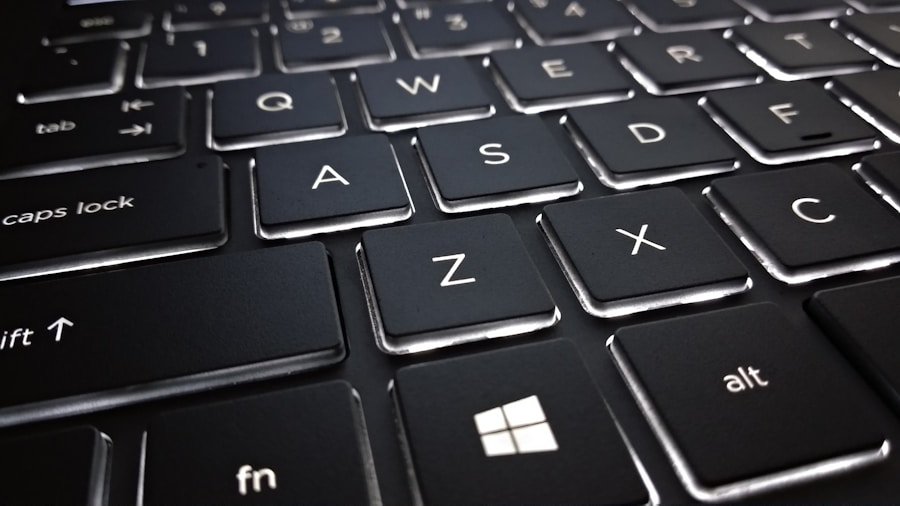Sticky Keys is an accessibility feature in Windows 11 designed to assist users who may have difficulty pressing multiple keys simultaneously. This function is particularly beneficial for individuals with motor impairments or those who find it challenging to execute complex keyboard shortcuts that require the use of multiple keys at once. When Sticky Keys is activated, users can press a modifier key—such as Shift, Ctrl, or Alt—and have it remain active until another key is pressed.
This allows for a more manageable way to execute commands that would typically require simultaneous key presses. For example, in a standard scenario where a user needs to copy text using the keyboard shortcut Ctrl+C, they would normally have to press both the Ctrl and C keys at the same time. However, with Sticky Keys enabled, the user can first press and release the Ctrl key, and then press the C key afterward.
This feature not only simplifies the process of using keyboard shortcuts but also enhances overall accessibility for those who may struggle with traditional keyboard use. The Sticky Keys function can be particularly useful in various applications, from word processing to gaming, where keyboard shortcuts are frequently employed.
Key Takeaways
- Sticky Keys in Windows 11 are a feature that allows users to press one key at a time for keyboard shortcuts, instead of having to hold down multiple keys simultaneously.
- To enable Sticky Keys in Windows 11, go to Settings > Accessibility > Keyboard and toggle the Sticky Keys switch to on.
- You might want to disable Sticky Keys in Windows 11 if you find that it is activating unintentionally or interfering with your typing or gaming experience.
- To disable Sticky Keys in Windows 11, go to Settings > Accessibility > Keyboard and toggle the Sticky Keys switch to off.
- To prevent Sticky Keys from re-enabling, you can adjust the settings in the Ease of Access Center or use a keyboard shortcut to turn it off temporarily.
- Additional accessibility features in Windows 11 include options for visual, auditory, and motor impairments, such as Magnifier, Narrator, and Mouse Keys.
How to enable Sticky Keys in Windows 11
Accessing Accessibility Features
Once in the Settings window, they should click on “Accessibility” from the left-hand menu. This section houses various features aimed at improving usability for individuals with different needs.
Enabling Sticky Keys
Within Accessibility, users will find an option labeled “Keyboard.” Clicking on this will lead to a series of keyboard-related settings. In the Keyboard settings, users will see an option for Sticky Keys. By toggling the switch to “On,” Sticky Keys will be activated. Additionally, there is an option to allow Sticky Keys to be turned on by pressing the Shift key five times in quick succession.
Customizing Sticky Keys Settings
Once enabled, users can customize further settings related to Sticky Keys, such as whether they want visual feedback when a modifier key is pressed or if they want to hear a sound when Sticky Keys is activated.
Why you might want to disable Sticky Keys in Windows 11

While Sticky Keys can be a valuable tool for many users, there are scenarios where disabling this feature may be preferable. One primary reason for disabling Sticky Keys is that it can interfere with regular typing and keyboard usage for individuals who do not require accessibility features. For instance, if a user frequently types or uses keyboard shortcuts that involve simultaneous key presses, having Sticky Keys enabled may lead to unintended actions or delays in executing commands.
This can be particularly frustrating in fast-paced environments where efficiency is crucial. Moreover, some users may find that the auditory or visual cues associated with Sticky Keys can be distracting or disruptive. For example, when a modifier key is pressed, a sound may play or a visual indicator may appear on the screen.
While these features are designed to assist users, they can become bothersome for those who do not need them. In such cases, disabling Sticky Keys can restore a more traditional typing experience and eliminate any distractions that may arise from its use. For more information on Sticky Keys and how to disable them, you can visit this Microsoft page.
How to disable Sticky Keys in Windows 11
| Method | Steps | Difficulty Level |
|---|---|---|
| Using Settings | 3 | Easy |
| Using Control Panel | 5 | Medium |
| Using Registry Editor | 7 | Hard |
Disabling Sticky Keys in Windows 11 is just as simple as enabling it. Users can return to the Settings app by clicking on the Start menu and selecting the gear icon. From there, they should navigate back to the Accessibility section and select “Keyboard.” In this area, users will find the option for Sticky Keys already toggled on if it was previously enabled.
To disable it, they simply need to switch the toggle to “Off.” This action will immediately deactivate the feature and restore standard keyboard functionality. Additionally, if users prefer to disable Sticky Keys using keyboard shortcuts, they can do so by pressing the Shift key five times consecutively. This method serves as a quick way to toggle the feature without delving into the Settings menu.
Once disabled, users will no longer experience any of the effects associated with Sticky Keys, allowing them to type and use keyboard shortcuts as they normally would without any interruptions or modifications to their input methods.
Tips for preventing Sticky Keys from re-enabling
For users who have disabled Sticky Keys but wish to ensure that it does not re-enable unexpectedly, there are several strategies they can employ. One effective method is to adjust the settings related to keyboard shortcuts within the Accessibility options. Users should navigate back to the Keyboard settings and look for any options that pertain to enabling Sticky Keys via keyboard shortcuts.
By disabling these options, users can prevent accidental activation through unintentional key presses. Another precautionary measure involves being mindful of how often certain keys are pressed during regular use. For instance, if a user frequently presses the Shift key multiple times in quick succession—perhaps while typing or gaming—they may inadvertently trigger the activation of Sticky Keys.
To mitigate this risk, users can practice more deliberate typing techniques or consider using alternative input methods that do not rely heavily on modifier keys. Additionally, keeping software and drivers up-to-date can help ensure that any bugs or glitches related to keyboard functionality are resolved promptly.
Additional accessibility features in Windows 11

Windows 11 offers a robust suite of accessibility features beyond just Sticky Keys, catering to a wide range of user needs. One notable feature is Narrator, a screen reader that provides audio descriptions of on-screen content, making it easier for visually impaired users to navigate their devices. Narrator can read text aloud from documents, web pages, and even menus within applications, allowing users to interact with their computers more effectively.
Another significant accessibility tool is Magnifier, which allows users to zoom in on specific areas of their screen for better visibility. This feature is particularly useful for individuals with low vision who may struggle to read small text or see intricate details on their screens. Magnifier can be adjusted for different levels of zoom and can follow the cursor as it moves across the screen.
Additionally, Windows 11 includes features like High Contrast mode, which enhances color contrast between text and background elements for improved readability. Users can customize color schemes according to their preferences and needs. Furthermore, Speech Recognition allows users to control their devices using voice commands, providing an alternative input method for those who may have difficulty using traditional keyboards or mice.
These accessibility features collectively enhance the usability of Windows 11 for individuals with diverse needs and preferences. By integrating such tools into its operating system, Microsoft aims to create an inclusive environment where all users can effectively engage with technology regardless of their physical abilities or limitations.
If you are looking for more information on how to customize your Windows 11 experience, you may want to check out this article on how to disable animations in Windows 11. This article provides step-by-step instructions on how to turn off animations to improve performance and reduce distractions while using your computer. By following these simple steps, you can further personalize your Windows 11 experience to suit your preferences.
FAQs
What are Sticky Keys in Windows 11?
Sticky Keys is a feature in Windows 11 that allows users to press one key at a time for keyboard shortcuts, rather than having to hold down multiple keys simultaneously.
How do I turn off Sticky Keys in Windows 11?
To turn off Sticky Keys in Windows 11, go to Settings > Accessibility > Keyboard > Sticky Keys, and then toggle the “Press one key at a time for keyboard shortcuts” option to off.
Can I disable Sticky Keys temporarily in Windows 11?
Yes, you can disable Sticky Keys temporarily by pressing the Shift key five times in quick succession. This will bring up a dialog box where you can turn off Sticky Keys for the current session.
Why would I want to turn off Sticky Keys in Windows 11?
Some users may find Sticky Keys to be an inconvenience, especially if they are used to traditional keyboard shortcuts that require holding down multiple keys at once. Turning off Sticky Keys can restore the normal behavior of keyboard shortcuts.
